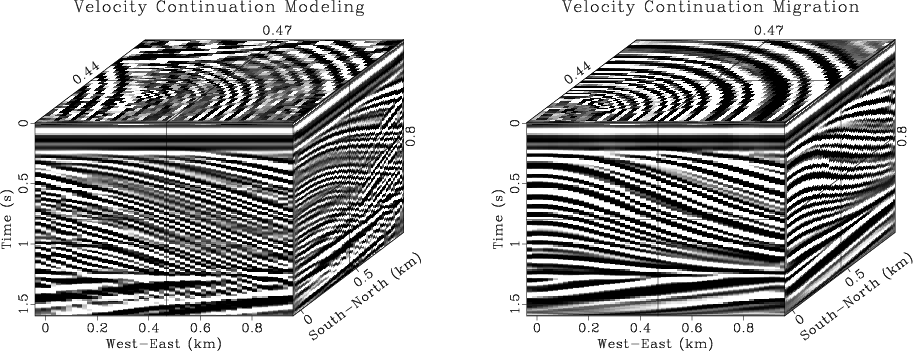|
|
|
|
Exploring three-dimensional implicit wavefield extrapolation with the helix transform |
Velocity continuation is a process of navigating in the migration
velocity space, applicable for time migration, residual migration, and
migration velocity analysis (Fomel, 1996a). In the
zero-offset (post-stack) case, the velocity continuation process is
described by the simple partial differential equation
(Fomel, 1994; Claerbout, 1986)

|
|---|
|
velcon
Figure 7. Impulse responses of the velocity continuation operator, computed by an implicit, unconditionally stable extrapolation via the helix transform. The left plot corresponds to continuation towards higher velocities (migration mode); the right plot, smaller velocities (modeling mode). |
|
|
The helix approach has allowed us to modify the old code for three dimensions. Figure 7 shows impulse responses of an implicit helix-based three-dimensional velocity continuation.
|
qdome
Figure 8. Qdome synthetic model, used for testing the 3-D velocity continuation program. |

|
|---|---|
|
|
Figure 9 illustrates the velocity continuation process on the Qdome synthetic model (Claerbout, 1997b), shown in Figure 8. Continuation backward in velocity corresponds to the ``modeling'' mode, while forward continuation corresponds to the ``migration'' mode. It is possible to balance the amplitudes of the two processes so that the finite-difference velocity continuation behaves as a unitary operator (Fomel, 1996a,b).

|
|---|
|
modmig
Figure 9. Modeling (left) and migration (right) with the Qdome synthetic model, obtained by running the 3-D velocity continuation backward and forward in velocity. |
|
|
|
|
|
|
Exploring three-dimensional implicit wavefield extrapolation with the helix transform |